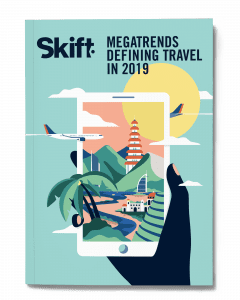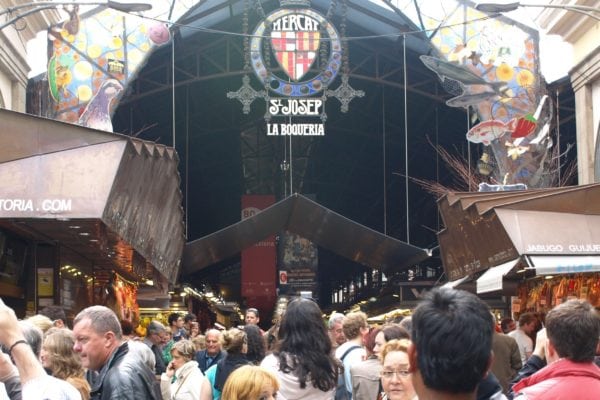Skift Take
Instead of narrowly segmenting service into dayparts, restaurants are thinking more fluidly, to all-day menus and creative late-night service.
— Danni Santana

We’ve just released our annual industry trends forecast, Skift Restaurant Megatrends 2019. You can read about each of the trends on Skift Table as well as download a copy of our magazine here.
Forget everything you thought you knew about restaurant dayparts: Customers are eating whatever they want, whenever they want it. And fast food chains, in particular, are looking to take advantage by luring diners back to stores throughout the day and late night too.
Whether it’s happy hour afternoon menus or after-dark snack options, there is a battle brewing outside of the infamous restaurant “breakfast wars.” Both afternoon and evening snacking are up 1.3 percent and 5.3 percent respectively, as of the end of September, compared to the fall of 2015, according to market research firm NPD Group. That number is only projected to go up in the years to come.
“I believe that the definition of meals, where and when we have them, is becoming more fluid,” said David Portalatin, VP, food industry advisor at NPD Group. “People are going to restaurants saying a hamburger, something we would consider lunch or dinner, is just a snack.”
“Late Night Wars”
The undisputed king of late-night dining is Taco Bell. The fast-food chain recently beat out McDonald’s as consumers’ favorite late-night food stop, according to a survey of 1,000 diners published by MattressAdvisor.
CEO David Gibbs said last spring that Taco Bell’s fastest-growing daypart is indeed after 5 p.m. To push that momentum forward, the company has rebranded and reintroduced its multi-packs of tacos as Taco Bell Party Packs for after-dark catering. The chain also began offering up 10 different store locations as host sites for parties in recent months, National Restaurant News reported.
“Taco Bell has developed a unique after-dark program, focused on fostering a culture of speed while maximizing satisfaction and delivering world-class service, targeting dinner and late-night peaks,” said Gibbs, on a conference call with investors last year.
Former Taco Bell CEO Brian Niccol, now the new boss of Chipotle, is gunning for crown he helped win when he was at the helm of the Yum! Brands subsidiary. Chipotle is in the middle of its promising comeback story; attempting to earn the trust of customers back after its food-safety scandal broke in 2016. In addition to pumping money into new “fresh ingredient” TV ads to improve sales, the chain began piloting $2 tacos and drinks after 8:00 p.m. in July to increase foot traffic by stealing customers away from Taco Bell.
Finding Your Afternoon Fix
For companies like McDonald’s and Starbucks, where customer traffic continues to be an issue, promotions and menu changes are ways to boost numbers, while catering to consumer demand during the day.
Back in 2015, McDonald’s introduced all-day breakfast when foot traffic was low, a move that brought much joy to its customers. The chain has since posted 13 consecutive quarters of positive same-store sales growth, and has even reverted back to tinkering with its popular menu to boost store visits again after consecutive subpar quarters of the metric. McDonald’s CEO Steve Easterbrook announced the company would introduce bigger, meatier breakfast sandwiches by the end of 2018 on a third quarter earnings call.
Meanwhile, Starbucks, in attempts to win at more than just breakfast, is relying on its cold platform — including nitro, cold brew, and cold foam drinks — and popular half off coffee specials for same-day returning customers looking for their afternoon fix. By moving most administrative tasks to closing time, employees are also finding more time to engage with customers in its stores, creating a more “homey” feel for coffee lovers to return to.
“We freed up time for the partners to interact with customers throughout the afternoon daypart,” Rosalind Brewer, Starbucks COO, group president of Americas, told investors in November. “And so we’re seeing some nice movement between our customer connection stores that we know ultimately will relates to increased frequency and traffic.”
Delivery’s Impact on Eating Times
Industry traffic issues aren’t all on restaurants. Delivery and the new gig economy are largely to blame for independents and large food chains’ troubles.
While unemployment levels are at record lows of fewer than 4 percent, it doesn’t tell the full story, Portalatin said. Much of that figure is tied to a changing U.S. demographic. Roughly 6.8 million people in the country earn income from untraditional means. Many also work unconventional hours.
“They are Uber drivers, DoorDash delivery drivers, and rent properties on Airbnb,” said Portalatin. “Going to work today is different than it was five years ago.”
More people than ever also work from home, which lends itself to the ordering more takeout, he added. Currently, a little less than half (49 percent) of all meals ordered from a restaurant are eaten at home. The result is a decrease in in-store customer traffic, and a subsequent 13 percent spike in off-premise demand since 2013, says NPD Group. The firm expects digital ordering through both restaurants’ proprietary websites and third-party platforms to grow 22 percent annually through 2020.
Restaurant chains are privy to this stat. About 60 percent of McDonald’s delivery orders come at off-peak hours, UberEverything boss Jason Droege said during the Skift Tech Forum in June. Uber Eats is the official delivery partner of McDonald’s.
“We’re seeing not just dayparts, but new occasions happening where folks are ordering maybe when you wouldn’t expect or because that convenience offers something different for them,” Liz Meyerdirk, global head of business development for Uber Eats, said in a separate interview with Skift Table in November.
The company, along with Grubhub, OpenTable and DoorDash, are just some of the major players in the delivery game equipped with multiple delivery contracts with restaurants. A few chains, such as Wingstop and Subway, sport more than one delivery partnership themselves.
Industry consensus is the delivery wave is here to stay due to convenience. But the increasing diversity and cuisines available, beyond just pizza, doesn’t hurt either.
Download Your Copy of Skift Megatrends 2019







